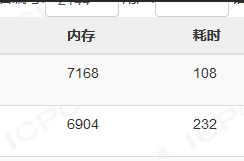读入挂(IO)
快如闪电,清华杜瑜皓的读入挂,一模一样代码,加了这个之后。。。
细思极恐,and 整整120行!!!

namespace IO{ #define BUF_SIZE 100000 #define OUT_SIZE 100000 #define ll long long //fread->read bool IOerror=0; inline char nc(){ static char buf[BUF_SIZE],*p1=buf+BUF_SIZE,*pend=buf+BUF_SIZE; if (p1==pend){ p1=buf; pend=buf+fread(buf,1,BUF_SIZE,stdin); if (pend==p1){IOerror=1;return -1;} //{printf("IO error!\n");system("pause");for (;;);exit(0);} } return *p1++; } inline bool blank(char ch){return ch==' '||ch=='\n'||ch=='\r'||ch=='\t';} inline void read(int &x){ bool sign=0; char ch=nc(); x=0; for (;blank(ch);ch=nc()); if (IOerror)return; if (ch=='-')sign=1,ch=nc(); for (;ch>='0'&&ch<='9';ch=nc())x=x*10+ch-'0'; if (sign)x=-x; } inline void read(ll &x){ bool sign=0; char ch=nc(); x=0; for (;blank(ch);ch=nc()); if (IOerror)return; if (ch=='-')sign=1,ch=nc(); for (;ch>='0'&&ch<='9';ch=nc())x=x*10+ch-'0'; if (sign)x=-x; } inline void read(double &x){ bool sign=0; char ch=nc(); x=0; for (;blank(ch);ch=nc()); if (IOerror)return; if (ch=='-')sign=1,ch=nc(); for (;ch>='0'&&ch<='9';ch=nc())x=x*10+ch-'0'; if (ch=='.'){ double tmp=1; ch=nc(); for (;ch>='0'&&ch<='9';ch=nc())tmp/=10.0,x+=tmp*(ch-'0'); } if (sign)x=-x; } inline void read(char *s){ char ch=nc(); for (;blank(ch);ch=nc()); if (IOerror)return; for (;!blank(ch)&&!IOerror;ch=nc())*s++=ch; *s=0; } inline void read(char &c){ for (c=nc();blank(c);c=nc()); if (IOerror){c=-1;return;} } //fwrite->write struct Ostream_fwrite{ char *buf,*p1,*pend; Ostream_fwrite(){buf=new char[BUF_SIZE];p1=buf;pend=buf+BUF_SIZE;} void out(char ch){ if (p1==pend){ fwrite(buf,1,BUF_SIZE,stdout);p1=buf; } *p1++=ch; } void print(int x){ static char s[15],*s1;s1=s; if (!x)*s1++='0';if (x<0)out('-'),x=-x; while(x)*s1++=x%10+'0',x/=10; while(s1--!=s)out(*s1); } void println(int x){ static char s[15],*s1;s1=s; if (!x)*s1++='0';if (x<0)out('-'),x=-x; while(x)*s1++=x%10+'0',x/=10; while(s1--!=s)out(*s1); out('\n'); } void print(ll x){ static char s[25],*s1;s1=s; if (!x)*s1++='0';if (x<0)out('-'),x=-x; while(x)*s1++=x%10+'0',x/=10; while(s1--!=s)out(*s1); } void println(ll x){ static char s[25],*s1;s1=s; if (!x)*s1++='0';if (x<0)out('-'),x=-x; while(x)*s1++=x%10+'0',x/=10; while(s1--!=s)out(*s1); out('\n'); } void print(double x,int y){ static ll mul[]={1,10,100,1000,10000,100000,1000000,10000000,100000000, 1000000000,10000000000LL,100000000000LL,1000000000000LL,10000000000000LL, 100000000000000LL,1000000000000000LL,10000000000000000LL,100000000000000000LL}; if (x<-1e-12)out('-'),x=-x;x*=mul[y]; ll x1=(ll)floor(x); if (x-floor(x)>=0.5)++x1; ll x2=x1/mul[y],x3=x1-x2*mul[y]; print(x2); if (y>0){out('.'); for (size_t i=1;i<y&&x3*mul[i]<mul[y];out('0'),++i); print(x3);} } void println(double x,int y){print(x,y);out('\n');} void print(char *s){while (*s)out(*s++);} void println(char *s){while (*s)out(*s++);out('\n');} void flush(){if (p1!=buf){fwrite(buf,1,p1-buf,stdout);p1=buf;}} ~Ostream_fwrite(){flush();} }Ostream; inline void print(int x){Ostream.print(x);} inline void println(int x){Ostream.println(x);} inline void print(char x){Ostream.out(x);} inline void println(char x){Ostream.out(x);Ostream.out('\n');} inline void print(ll x){Ostream.print(x);} inline void println(ll x){Ostream.println(x);} inline void print(double x,int y){Ostream.print(x,y);} inline void println(double x,int y){Ostream.println(x,y);} inline void print(char *s){Ostream.print(s);} inline void println(char *s){Ostream.println(s);} inline void println(){Ostream.out('\n');} inline void flush(){Ostream.flush();} #undef ll #undef OUT_SIZE #undef BUF_SIZE };
无法从黑框输入数据,只能从文档测了,所以有必要。。。
用法举例:
freopen("YuEr.in","r",stdin); freopen("YuEr","w",stdout); IO::read(t); IO::print(i),IO::print(' ');IO::println(n);




